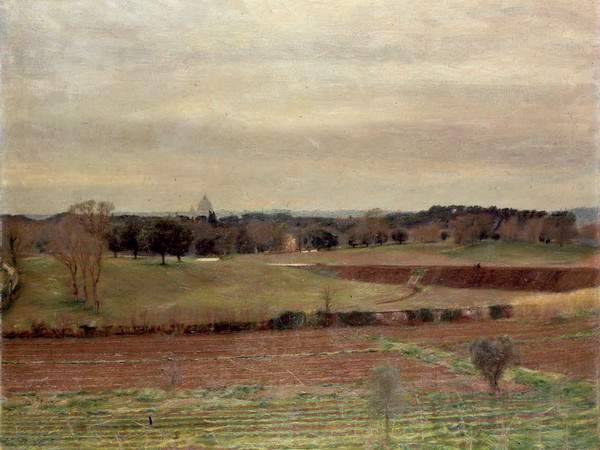Rome, an anthological exhibition on Giacomo Balla at Villa Borghese
The Museo Carlo Bilotti - Aranciera di Villa Borghese, located in the heart of the great Roman park, will host from November 28, 2018 to February 17, 2019 the anthological exhibition Balla a Villa Borghese, dedicated to Giacomo Balla (Turin, 1871 - Rome, 1958). It is an opportunity to present a focus focused exclusively on the works painted at the Villa, with a survey of the artist’s early pictorial production, which, not yet a Futurist, is already aimed at the study of light and color.
The exhibition, curated by art historian Elena Gigli, a scholar who has been engaged for years in cataloguing Balla’s work, begins after Balla’s marriage to Elisa Marcucci: following the event, the artist moved in the summer of 1904 to an old monastery at Via Parioli 6, today’s Via Paisiello, on the corner of Via Nicolò Porpora. In the cell-rooms of this happy corner of nature, carved out on the outskirts of the city and very different from today’s Parioli district, the painter established his home and painted what he saw from the balcony of his studio or immediately outside the door of the dwelling. Until 1910, the year he produced the great Villa Borghese polyptych, the theme of nature on the edge of the city became for Balla what the Montagne Sainte-Victoire is for Paul Cézanne: subject matter to be investigated, to be tried and tried again, to be scarified to the point of abstraction. This is one of the earliest experimental themes tackled by the painter, presented on this occasion through some 30 works brought together organically, just as they will be, at the heroic age of Futurism, the themes of the Swallow, seen from the same balcony, theRacing Automobile, Abstract Speed, Lines Force of Landscape, Transformations Forms Spirit, Mercury Passing Before the Sun, and so on.
In the rooms on the second floor of the Museum, an extension of the exhibition actualizes Balla’s “photographic gaze” through a series of shots by photographer Mario Ceppi taken in the same places as the paintings on display. The exhibition will also feature the film by Jack Clemente (Novara, 1926 - Milan, 1974) Balla and Futurism, winner of the Silver Lion Award at the 1972 Venice Biennale in the art documentary section. The song Echoes by Pink Floyd, used in the film’s soundtrack, was granted to Clemente by the band, whom he met during the filming of Adrian Maben ’s concert film Pink Floyd in Pompeii in 1971, followed on assignment by producer Michéle Arnaud. The protagonists of the story (the French edition is 52 minutes, the Italian version 32) are Balla’s daughters, Elica and Luce. The extraordinary apartment on Via Oslavia is the documentary’s big attraction. For it takes us along the corridor, into the rooms, past the window of the dwelling where the artist put into action that “Futurist Reconstruction of the Universe” theorized in 1915 with Depero.
Clement, an artist who moved to Paris, devoted himself to painting from 1952, and his first exhibition was in 1953 moving, at first, between lyrical abstraction and informal. In 1958 he met Carlo Cardazzo and Lucio Fontana and approached Spatialism. With the Galleria del Cavallino in Venice and Il Naviglio in Milan he maintained a privileged relationship since the 1960s, beginning to use “other” materials such as rope and jute. Frequent exhibitions also abroad both personal and collective. From 1969 he began a collaborative relationship with French Television and Rai and made a series of films on the protagonists of painting and music. Assistant to Jacques Averty for the"Emission 4 Temps," an afternoon program in which the most important performers of those years, such as Françoise Hardy, Jacques Dutronc, Johnny Halliday , Silvie Vartan, sing accompanied by sets by Capogrossi, Sonia Delaunay, Wassily Kandinsky, Victor Vasarely, David Hockney, he participates in Adrien Maben’s film “Pink Floyd in Pompeii.” The following year he made, again for French Television in collaboration with RAI, The Inimitable Life dedicated to Gabriele D’Annunzio while his last film, Rauschenberg and Pop Art, would be completed by Rauscenberg himself due to worsening illness. His works can be found in public and private Italian and international collections such as the Tate Gallery, Musèe de Strasbourg, Mart in Rovereto, Gallerie d’Italia, and the Boschi Collection in Milan. In 2013, two exhibitions on his work were organized by Studio Gariboldi in Milan and Bergamo and a catalog presented by Francesco Tedeschi was published.
Admission is free for both the exhibition and the museum.
For all information you can call +39 060608, send an e-mail to info@museocarlobilotti.it or visit www.ballavillaborghese.it.
The exhibition is promoted by Roma Capitale, Assessorato alla Crescita culturale - Sovrintendenza Capitolina ai Beni Culturali with the collaboration of Galleria Mucciaccia in Rome, the exhibition is produced by The Boga Foundation. Zètema Progetto Cultura museum services.
Pictured: Giacomo Balla, Villa Borghese from the Balcony (c. 1907; oil on canvas, 100 x 120 cm, private collection)
 |
| Rome, an anthological exhibition on Giacomo Balla at Villa Borghese |
Warning: the translation into English of the original Italian article was created using automatic tools. We undertake to review all articles, but we do not guarantee the total absence of inaccuracies in the translation due to the program. You can find the original by clicking on the ITA button. If you find any mistake,please contact us.




























